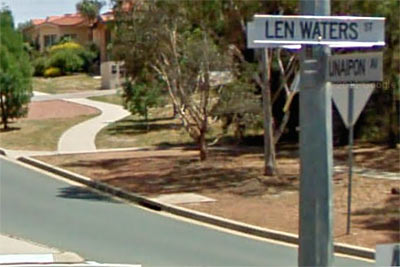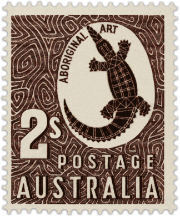History
Timeline results for
Found 1175 results for your search. Showing page 11 of 59.
1940
-
White Australia policy succeeds: 99% of Australia’s 7 million people are white.
1941
-
The Child Endowment Act is passed but declares no endowment should be paid to dependent Aboriginal people.
-
Dick and Lyn Johnson play in the position of fullback against each other in the City–Country game.
1942
-
Darwin is bombed by the Japanese. In Arnhem Land, Aboriginal people make up a special reconnaissance unit in defence of Australia. Northern Territory Aboriginal missions are evacuated. Many Aboriginal people evacuated after the bombing are transferred to ‘control camps’ in Victoria, South Australia or New South Wales and some never return. Restrictions are placed on Aboriginal movement, especially of women.
-
19-year old Len Waters becomes the first Aboriginal military pilot to be accepted into the Royal Australian Air Force (RAAF). [1] He is also the only Aboriginal fighter pilot to serve during World War II. Len left the air force in 1946 and died in 1993 aged 69. Streets in ACT and Sydney bear his name, and in October 2020 the Department of Defence named a building at RAAF Base Williamtown (30 kms north-east of Newcastle, NSW) after him. [2]

Len Waters Street in Ngunnawal, Australia Capital Territory. -
The Methodist Church in North Australia sets up an Aboriginal mission on Elcho Island, Northern Territory.
1943
-
A further amendment to the Aboriginal protection legislation in NSW gives two Aboriginal people – one ‘full-blood’ and one ‘half-caste’ – representation on the Aboriginal Welfare Board. Walter Page and William Ferguson, both Aboriginal Progressive Association members, take up the positions.
-
Formation of the Torres Straight Light Infantry Battalion. 880 men enlist, about 90% of the total male population of the Islands. Their discipline and work ethic sees them in high regard among fellow soldiers. In small groups they patrolled the islands close to Papua New Guinea monitoring the movements of Japanese forces. Yet, they only receive half of the wages of their peers.
-
The Aborigines Welfare Fund is set up "for the general benefit of Aboriginal people". The fund received income from government-operated retail stores, child endowment benefits and Aboriginal wages. Until 1966 a compulsory deduction from Aboriginal peoples' wages was transferred to the fund.
-
The NSW government passes the Aborigines Protection (Amendment) Act 1943 which in Section 18c introduces Exemption Certificates that allow certain Aboriginal people to be exempted from the restrictive legislation and entitled to similar rights as non-Aboriginal people, e.g. to vote, drink alcohol and move freely and send their children to school. In return they "shall be deemed not to be an aborigine [sic]" which means they have to give up their cultural activities and contacts to family and community. The Act remains in force until 1969.
Aboriginal people use the derogatory terms ‘dog tags’ or ‘dog licences’ to refer to the certificates. Giving up their traditional lifestyle is promoted to Aboriginal people as the only opportunity to overcome poverty, gain work and access to education and social welfare benefits.
1945
-
Aboriginal cattle station workers in the Port Hedland district of Western Australia strike for a pay increase. They are getting 10 shillings a week and are supplied with blankets. Aboriginal people then form a co-operative to mine alluvial wolfram which was successful.
-
An investigation shows Aboriginal people on Lord Vestey’s Northern Territory cattle station are getting poor rations, inadequate housing, water and sanitation facilities and are paid less than the five shillings a day minimum wage, which was set for Aboriginal people in a 1918 ordinance. European males receive two pounds and eight shillings (equal to 48 shillings) a week in 1945.
-
Bill Onus, organising in Redfern, co-founds the Redfern All Blacks Rugby League team which would become a community and political organisation throughout the 50s and 60s.
1946
-
Aboriginal children need a medical certificate to attend public schools.
-
Aboriginal pastoral workers initiate the Pilbara strike in Western Australia over pay, conditions and ill treatment.
1948
-

Designed by a non-Aboriginal artist, this 2-shilling stamp is the first to show an Aboriginal art theme. Australia Post releases the first Australian stamp that features an Aboriginal art theme. The 2 shilling stamp represents a crocodile in the style of a rock painting and is part of the Australian Animals definitive stamp issue of that year. But the artist, Gert Sellheim, is not Aboriginal.
-
The Universal Declaration of Human Rights is adopted by the newly-formed United Nations and supported by Australia.
-
The Commonwealth Citizenship and Nationality Act 1948 for the first time makes all Australians, including all Aboriginal people, Australian citizens. But at state level they still suffer legal discrimination.
1949
-
Aboriginal people are given the right to enrol and vote at federal elections provided they are entitled to enrol for state elections or have served in the armed forces.
-
The Convention on the Prevention and Punishment of the Crime of Genocide is ratified by Australia. It comes into force in 1951.
References
View article sources (2)
[1]
'First Indigenous military pilot remembered', Koori Mail 525 p.15
[2]
'Building named to honour Indigenous fighter pilot', Department of Defence, 27/10/2020, available at news.defence.gov.au/national/building-named-honour-indigenous-fighter-pilot; thanks to my subscriber
Flurgen for letting me know.

